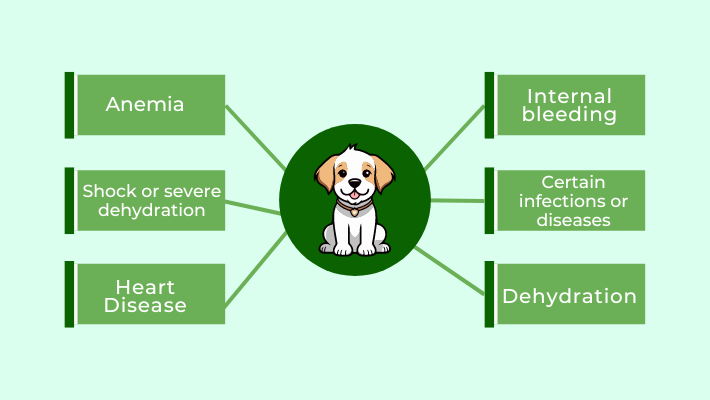Pale Gums In Dogs: Everything You Need To Know


Are your dog’s gums looking paler than usual? Pale gums in dogs can be a cause for concern. This is because, most of the time, a change in a dog’s gum color is an indication of an underlying health issue, some more serious than others.
Thus, pale gums in dogs, or gums that appear lighter than their usual pink hue should never be ignored. In this comprehensive guide, we will delve into what healthy gums look like, explore the common causes of pale gums, and provide guidance on what to do if you notice this sign in your dog.
Understanding the causes of pale gums in dogs will enable you to ensure that your canine companion receives the care they need. So let’s get started.
Understanding The Normal Color Of Dog Gums

Before we dive into the intricacies of pale gums, it’s essential to understand what constitutes a healthy gum color in dogs. A healthy dog’s gum color should ideally be a powdery pink, similar to the color of cooked shrimp or uncooked salmon. However, there can be some variations depending on the breed.
This color is a result of adequate blood flow and oxygenation within the gum tissue. However, it’s important to note that some variations in gum color can occur naturally due to factors such as breed, age, and individual differences. For instance, some dog breeds, like Chow Chows, Shar-Peis, Shih Tzus, and Pugs, naturally have pigmented gums. These gums may have black, blue, or splotchy markings, but they should still have some underlying pink color. This pinkness is an indicator of good blood circulation in dogs.
Here are some additional things to consider when checking your dog’s gum color:
- Moistness: Healthy gums should be moist and smooth to the touch, not dry or sticky. This indicates that your pup is thoroughly hydrated.
- Capillary Refill Time (CRT): Gently press on your dog’s pink gum with your finger for a second, then release. The gum should turn white briefly and then return to its normal pink color within two seconds. This refill time indicates healthy blood flow
What Causes Pale Gums In Dogs?

Pale gums in dogs can be a symptom of various underlying health issues. Here are some common causes that may lead to this condition:
Anemia
One of the most common reasons for pale gums in dogs is anemia. This refers to a condition where there is a deficiency of red blood cells or hemoglobin in the dog’s body. Red blood cells carry oxygen throughout the body, so when there aren’t enough of them, the gums can appear pale. Aside from pale gums, other signs of anemia in dogs include weakness, lethargy, decreased appetite, weight loss, difficulty breathing, and increased heart rate.
Also note that signs and symptoms of anemia seen in dogs can vary depending on duration, underlying cause, and severity. Most of the time, Anemia is not a separate condition but a sign of an underlying condition.
Anemia in dogs can be caused by various factors, including blood loss, reaction to certain medications, nutritional deficiencies, parasitic infections, immune system issues, or health issues such as cancer, kidney and liver disease. If the underlying condition causing the anemia is not treated on time, then it can cause the dog to go into shock and can even be fatal.
Shock Or Severe Dehydration
Shock in dogs is a serious life-threatening condition that occurs when there is a lack of proper blood circulation within the body. As a result, the cells dont have enough oxygen to produce energy.
When a dog experiences shock, their body may redirect blood flow away from non-essential areas like the gums and give priority to vital organs like the brain, heart, and kidney. As a result, dogs in shock have pale, discolored, or white-colored gums.
Dogs can experience shock for a variety of reasons, such as internal or external hemorrhage, dehydration, sepsis, anaphylaxis, heart failure (when the heart is so weak that it is unable to properly pump blood throughout the body), and so on.
If you suspect that your dog is in shock, then the first thing that you need to do is to take them to the nearest vet clinic for emergency medical treatment. On the way, you need to stay calm and help your dog stay calm. A dog experiencing shock is already agitated, so you should avoid doing anything that stresses them out more.
While waiting for medical treatment, you also need to ensure that your dog is in a quiet, comfortable area. If your dog is still conscious, then you should:
- Gently position them on their right side with their head extended. This helps keep their airway open.
- Elevate their hindquarters slightly with a blanket or pillow. This improves blood flow to vital organs.
- Cover them with a blanket to retain body heat.
Heart Disease
Certain heart conditions, such as congestive heart failure, weaken the heart so much that it is unable to pump blood and circulate it effectively throughout the body. As a result, blood starts to back up into the lungs and leads to fluid accumulating in either the abdomen, the chest, or both. This results in reduced oxygen supply to the tissues, which causes the gums to appear pale in color.
Internal Bleeding
If your dog is experiencing internal bleeding, whether due to a trauma, ulcer, or other medical condition, it can result in a huge loss of blood volume, leading to anemia. One of the first signs of anemia in dogs is pale gums. It can be life-threatening if not addressed promptly.
Certain Infections Or Diseases
In some cases, pale gums may be a symptom of underlying infections or diseases, such as parasitic infestations, cancer, or autoimmune disorders. For instance, internal parasites like hookworms, roundworms, and tapeworms latch onto the lining of a dog’s small intestine and feed on blood. These cause severe blood loss, leading to pale gums, lethargy, decreased appetite, and weight loss. It is particularly dangerous for puppies, who can become severely anemic from blood loss caused by hookworms.
Tick-borne diseases such as Ehrlichiosis and Babesiosis attack a dog’s immune system and destroy red blood cells. This destruction leads to severe blood loss and anemia, causing pale gums in dogs.
Dehydration
The four main components present in the blood are plasma, red blood cells, white blood cells, and platelets. Plasma is the liquid part that constitutes more than half of the total volume of the blood and where the platelets, red blood cells, and white blood cells are suspended. It is made up of mostly water, protein and dissolved salts and carries blood cells throughout the body.
When a dog is dehydrated, their body loses fluid. This loss of fluids reduces the amount of plasma in the blood, making the blood thicker and more concentrated. Thick blood flows less easily through blood vessels. This can lead to reduced blood flow to the gums, causing them to appear pale pink, white, or even grayish instead of their normal healthy pink color.
What To Do If My Dog Has Pale Gums?

As you can see from the above section, pale gums in dogs are not a stand-alone medical condition. Rather, it is an indication that your dog is suffering from one or more underlying health problems. In such cases, there may be other accompanying symptoms that can help you identify the underlying issue. Here are some common symptoms to watch out for:
- Lethargy or weakness: If your dog appears lethargic, lacks energy, or seems weaker than usual, it could be a sign of an underlying health problem.
- Loss of appetite: A decreased appetite or refusal to eat can be an indicator of various health issues, including those that may cause pale gums.
- Rapid breathing or panting: Rapid or labored breathing can be a sign of shock, anemia, or heart-related issues, which may also cause pale gums.
- Bruising or bleeding: If you notice any unexplained bruising or bleeding, it could be a sign of a clotting disorder or internal bleeding, both of which can lead to pale gums.
- Pale or yellow tongue: In some cases, pale gums may be accompanied by a pale or yellowish tongue, which can indicate liver or gallbladder problems.
When To Consult A Vet For Pale Gums In Dogs
If you notice that your dog’s gums have become pale or lighter than their usual color, it’s essential to seek veterinary attention promptly.
Here are some situations where you should consult your vet:
- If the pale gums are accompanied by other symptoms, such as lethargy, loss of appetite, or rapid breathing.
- If the pale gums persist for more than a day or two, even without other symptoms.
- If your dog has recently experienced trauma or an injury that may have caused internal bleeding.
- If your dog is taking any medications that may be causing pale gums as a side effect.
- If your dog is a senior or has any pre-existing medical conditions that may increase the risk of underlying health issues.
Remember, pale gums can be a symptom of various health problems, some of which may be serious or life-threatening. It’s always better to err on the side of caution and have your veterinarian evaluate your dog’s condition.
Diagnostic Tests And Examinations For Pale Gums In Dogs

If your veterinarian suspects an underlying health issue based on your dog’s pale gums and accompanying symptoms, they may recommend various diagnostic tests and examinations to determine the root cause.
Here are some common tests and procedures that may be performed:
- Complete blood count (CBC): A CBC is a blood test that measures the levels of red blood cells, white blood cells, and platelets. This test can help diagnose conditions like anemia, infections, or blood disorders.
- Blood chemistry profile: This test evaluates the levels of various substances in the blood, such as enzymes, electrolytes, and proteins. It can provide valuable information about organ function and metabolic processes.
- Urinalysis: A urinalysis can help detect the presence of blood, proteins, or other abnormalities in the urine, which may indicate certain health issues.
- Fecal examination: In cases where parasitic infections are suspected, your vet may recommend a fecal examination to look for the presence of parasites or their eggs.
- Imaging tests: Depending on the suspected underlying condition, your vet may recommend imaging tests like X-rays, ultrasounds, or CT scans to visualize internal organs and structures.
- Endoscopy or exploratory surgery: In some cases, an endoscopic examination or exploratory surgery may be necessary to investigate potential internal bleeding or other issues that cannot be detected through non-invasive methods.
Treatment Options For Pale Gums In Dogs

The treatment for pale gums in dogs will depend on the underlying cause identified through diagnostic tests and examinations. Here are some common treatment options:
- Medication: Depending on the condition, your vet may prescribe medications such as antibiotics, deworming medications, or supplements to address specific issues like infections, parasitic infestations, or nutritional deficiencies.
- Blood transfusion: In cases of severe anemia or blood loss, a blood transfusion may be necessary to restore proper red blood cell levels and improve oxygenation.
- Fluid therapy: If your dog is dehydrated or in shock, intravenous fluid therapy may be administered to stabilize their condition and restore proper hydration levels.
- Surgery: In some cases, such as internal bleeding or obstructions, surgical intervention may be required to address the underlying issue.
- Dietary changes: Depending on the condition, your vet may recommend dietary modifications, such as a specialized diet or nutritional supplements, to support your dog’s recovery and overall health.
- Supportive care: In addition to specific treatments, your vet may recommend supportive care measures, such as rest, monitoring, and follow-up visits, to aid in your dog’s recovery.
If you’re concerned about your dog’s gum color or overall health, don’t hesitate to consult with your trusted veterinarian. They have the expertise and resources to properly diagnose and treat any underlying issues, ensuring your beloved pet receives the best possible care.
Final Thoughts: Importance Of Monitoring Your Dog’s Gum Color
Pale gums in dogs can be a warning sign of various underlying health issues, some of which may be serious or even life-threatening if left untreated. As a responsible pet parent, it’s crucial to monitor your dog’s gum color regularly and seek veterinary attention quickly if you notice any changes or accompanying symptoms.
At the same time, you should also ensure that your dog is eating a balanced and nutritious diet can help prevent nutritional deficiencies that may contribute to anemia or other health issues.
Remember, early detection and prompt treatment can significantly improve the outcome and quality of life for your furbaby. By being proactive and attentive to your dog’s health, you can help ensure they receive the care they need and enjoy a long, happy, healthy life by your side.
ADDITIONAL READING:








All Comments
24 May, 2024
Your writing was remarkably illuminating! The breadth of information and the captivating delivery mesmerized me. The depth of research and mastery evident throughout significantly heightens the content's excellence.Thank you for sharing your expertise and enhancing our understanding of this topic. I'll certainly return for more updates.
Reply
Amaya
24 May, 2024
Your work was remarkably enlightening! The thoroughness of the information and the riveting delivery enthralled me. The depth of research and proficiency evident throughout significantly heightens the content's excellence. The insights in the introductory and concluding portions were particularly compelling, sparking new concepts and inquiries that I hope you'll explore in future writings. Gratitude for sharing your expertise and enriching our understanding of this subject. The exceptional quality of this piece compelled me to comment promptly after perusing. Your dedication to crafting such an outstanding article is highly valued!
Reply
Rasheed
28 May, 2024
The logical flow of information kept me thoroughly engaged from start to finish. The knowledge shared here has significantly broadened my understanding and ignited my curiosity for more. I felt compelled to express my appreciation immediately after reading due to the exceptional quality of this article. Your dedication to crafting such outstanding content is highly appreciated, and I eagerly await future updates. Please continue with your excellent work—I will definitely be returning for more insights. Thank you for your unwavering commitment to sharing your expertise and for greatly enriching our understanding of this subject.
Reply
29 May, 2024
This piece was incredibly enlightening! The level of detail and clarity in the information provided was truly captivating. The extensive research and deep expertise evident in this article are truly impressive, greatly enhancing its overall quality. The insights offered at both the beginning and end were particularly striking, sparking numerous new ideas and questions for further exploration.The way complex topics were broken down into easily understandable segments was highly engaging.
Reply
Dorcas
2 June, 2024
Thank you for sharing such an insightful and well-written article. I appreciate the thorough research and clear presentation of the topic. Your ability to break down complex concepts into easily understandable information is impressive and beneficial for readers. I look forward to reading more of your content and learning from your expertise. Keep up the great work!
Reply
Arjun
18 June, 2024
What a remarkable article! The way you’ve tackled the topic with such precision and depth is commendable. Readers are sure to gain a great deal from the wealth of knowledge and practical insights you’ve shared. Your profound understanding of the subject shines through every part of the piece. I'm eager to see more of your exceptional work. Thank you for offering your expertise and providing us with such enlightening and comprehensive content.
Reply